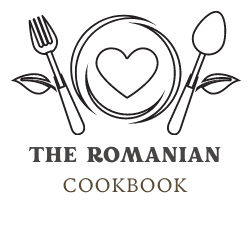I’ve been thinking for a long time to write about “mamaliga”, this staple of the Romanian cuisine. But I’ve always delayed it because, even if it’s such a humble traditional dish, is so embedded into us, Romanians, that any way I’d explain the recipe, would create controversy. This is because no mamaliga is the same. My mamaliga won’t be the same as your mamaliga, and this is because everyone makes it their own way. And that might sound intriguing, knowing that you only really need two ingredients to make it.
But let’s start with what exactly is “mamaliga” and why is it such a loved Romanian food. Even calling it “food” seems, somehow, wrong. I remember my first encounters with mamaliga, when, as a child, I would have it for both lunch and then dessert, afterwards. My grandfather would make it in a large “ceaun”, a typical Romanian cauldron-like font pot, and we would usually eat it alongside the chicken and garlic stew my grandma would prepare. When all the mamaliga would be taken out of the ceaun, my grandfather would pour milk on the leftovers stuck to the pot and heat it up, creating a completing different dish that us, children, would devour as dessert. I still remember the addictive taste of those burnt bits mixed with the sweet milk.
Mamaliga, or Romanian polenta, as we don’t want to confuse it with the Italian version which is very different in my opinion, has been traditionally a bread substitute. In the countryside, farm workers would take it in the field with them, to have for lunch alongside slices of Slanina (slabs of pork fat with the skin on), cheese, and onions. This is why the Romanian polenta is usually cooked to be thick, so it can be cut in slices. However, there are plenty of recipes that include mamaliga, which use it in different consistencies, such as Romanian bulz, Romanian balmos, or simply mamaliga with fried sausages, Romanian cheese, sour cream and sunny side-up eggs. In the Danube Delta, the locals even mix tomatoes and onions in it, which goes so well with fish.
In this post I will guide you on how to make Romanian polenta. It’s up to you to personalise it and make it to your own preferred consistency.
Ingredients for the Traditional Romanian Polenta Recipe

Romanian mamaliga has only a handful of ingredients, which makes the quality of each one matter.
To make traditional mamaliga, you will need cornmeal (malai), water, and salt. That’s it. I personally love adding a little butter towards the end for extra creaminess, but that’s optional and not something every household does.
The base quantities are straightforward:
250 g cornmeal per 1 litre of water, plus 1 teaspoon of salt per litre.
How to Make Romanian Mamaliga

To make authentic Romanian mamaliga, choose a pot with a thick base, traditionally a ceaun, but a Dutch oven or any heavy pot will work well.
Start by pouring the desired amount of water into the pot and adding a teaspoon of salt per litre. Bring the water to a boil. Once it starts bubbling, begin adding the cornmeal in a slow, steady “rain” motion, whisking continuously. This step is crucial. Using a whisk instead of a wooden spoon helps break up the cornmeal and prevents those pesky clumps from forming.
Lower the heat to minimum and keep whisking for a couple more minutes as the mixture thickens. Then cover the pot and let it simmer gently for 10 minutes.
At this point, you can serve your mamaliga as it is, soft, warm, and comforting. But if you want it to be sliceable, like the traditional version, there’s one more step. After turning off the heat, let it rest, covered, for another 10 minutes.
Turn the heat back on for one more minute, then switch it off. Remove the lid, place a wooden board on top, and flip the pot upside down. Thanks to the steam inside, the mamaliga will slide out perfectly, holding its shape.
Slice it using a piece of string, not a knife, as Romanians do.
Serve as a side dish, use it in another recipe, or simply enjoy it warm with cheese and sour cream.
Notes and Tips

- A small knob of butter whisked in at the end makes the polenta smoother and creamier.
- Adjust the cornmeal amount based on how thick or soft you like it.
- Medium or coarse cornmeal works best; very fine cornmeal becomes porridge-like. Use Romanian “malai”, which you can find in any Eastern European shop.

Traditional Romanian Polenta Recipe
Ingredients
- 1 litre water
- 250 gr cornmeal medium-ground, look for Romanian malai
- 1 tsp salt
- 1 tbsp butter optional
Instructions
- Pour the water into a heavy pot (like a Dutch oven) and add the salt. Bring to a boil.
- Once boiling, slowly sprinkle in the cornmeal in a thin “rain” while whisking continuously.
- Reduce heat to low and continue whisking for 1–2 minutes until the mixture thickens.
- Cover with a lid and let the mamaliga simmer for 10 minutes
- Optional: whisk in a tablespoon of butter for a creamier texture.
- For a soft mamaliga, serve now.
- For a firm, sliceable mamaliga::
- – Turn off the heat and let it rest, covered, for another 10 minutes.
- – Turn the heat back on for 1 minute, then switch off again.
- – Replace the lid with a wooden board, flip the pot upside down, and let the mamaliga slide out.
- Cut using string (traditional Romanian method) and serve warm.
FAQ
Is Romanian mamaliga the same as Italian polenta?
No. Although both use cornmeal, Romanian mamaliga is usually much thicker and firmer, but when cooked for a different purpose, it can se soft and creamy.
Can I make mamaliga without a ceaun?
Absolutely. Any thick-bottomed pot works, like a Dutch oven or a heavy saucepan.
Why is my mamaliga lumpy?
You must whisk as you pour the cornmeal. Adding it too quickly or not whisking enough causes clumps.
For more traditional Romanian dishes, check out my recommendations low:
Like it? Pin it!





